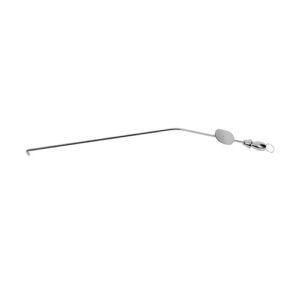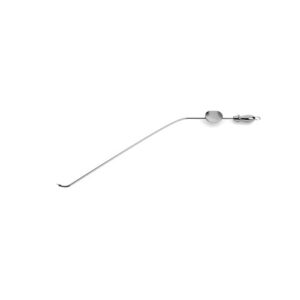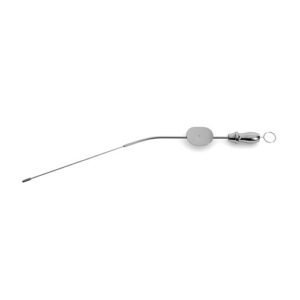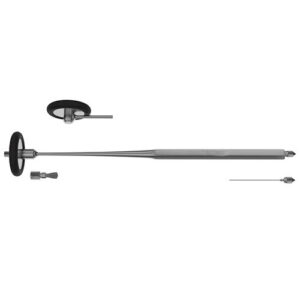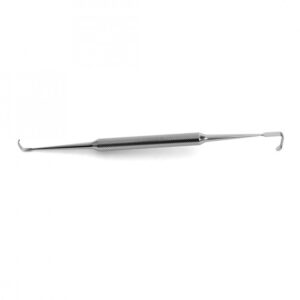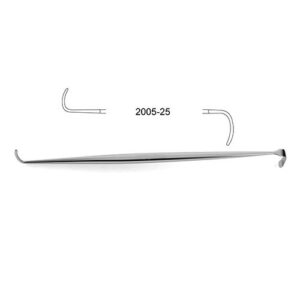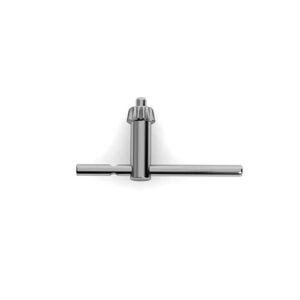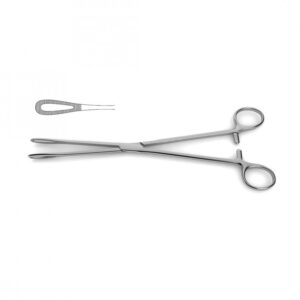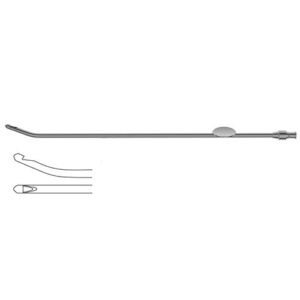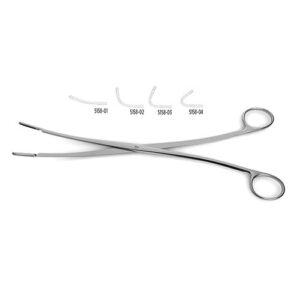R-Type Atraumatic Suction Tube – Curved Down Tip
curved down tip, angled tube, 5-1/4" (13.0 cm) working length R-Type Atraumatic Suction Tube is a device that has wide surgical applications. It can be affixed to a suction machine to aide in clearing the surgical field to increase visible and access for the surgeon. This tube features a curved down tip and an angled tube and is unique designed to prevent trauma to the surround tissue layers as it is used in and around the surgical incision. This instrument is available in four sizes 5 fr, 7 fr, 10 fr and 12 fr.
R-Type Atraumatic Suction Tube – Curved Up Tip
curved up tip, angled tube, 5-1/4" (13.0 cm) working length R-Type Atraumatic Suction Tube is a device that has wide surgical applications. It can be affixed to a suction machine to aide in clearing the surgical field to increase visible and access for the surgeon. This tube features a curved up tip and an angled tube and is unique designed to prevent trauma to the surround tissue layers as it is used in and around the surgical incision. This instrument is available in four sizes 5 fr, 7 fr, 10 fr and 12 fr.
R-Type Atraumatic Suction Tube – Straight Tip
straight tip, angled tube R-Type Atraumatic Suction Tube is a device that has wide surgical applications. It can be affixed to a suction machine to aide in clearing the surgical field to increase visibility and access for the surgeon. This tube features a straight tip and an angled tube and is unique designed to prevent trauma to the surround tissue layers as it is used in and around the surgical incision. This instrument is available in ten different sizes to conform to any particular patient need and surgeon preference.
Rabiner Neurological Hammer
Rabiner Neurological Hammer
9" (22.9 cm)
Rabiner Neurological Hammer is designed for usage in diagnostic evaluation of neurological function. This hammer features a unique crown shaped head that enables it to be used in positions both perpendicularly as well as parallel to its shaft. Additionally this instrument features a pointed tip for pinprick testing.
Ragnell (Kilner) Scissors
Ragnell (Kilner) Scissors
Ragnell (Kilner) Scissors are designed with flat, blunted tips to cut only tissue. The instrument is handcrafted from surgical grade German stainless steel and available with straight or curved blades. For the curved blade there is a wide range of lengths that can accommodate usage in a variety of surgical settings.
Ragnell (Kilner) Scissors – Supercut
supercut, curved, flat & blunt tips
Ragnell (Kilner) Scissors are designed with curved, flat, blunted tips at the distal end, to cut only tissue. Available in varying lengths, all with black-coated ring handles for comfort and control and handcrafted from surgical grade German stainless steel. Supercut blades assure ease of use and tissue grip. Supercut scissors are designed to provide the surgeon with maximum control. These scissors feature specially-designed razor sharp upper blade edges to cut effortlessly and cleanly through dense or delicate tissue, have diamond-cut micro-serrations on the lower blade to grip tissue and prevent slippage, and feature black-coated handles.
Ragnell Retractor – Round Handle
Round Handle
round handle, double-ended, 3.0mm x 8.0mm blades, 5.0mm x 15.0 mm blades, 6-1/4" (16.0 cm)
Ragnell Retractor can be applied during general surgical procedures, particularly during small orthopedic procedures. For instance, the retractor features blades on both ends of the handle and can be used to elevate structures that keep organs or tissues in place. Made from premium grade stainless steel, this instrument is resistant to corrosion even after frequent sterilization.
Ragnell Retractor – Standard Handle
Standard handle, double-ended, 3.0mm x 8.0mm blades, 5.0mm x 15.0 mm blades, 6-1/4" (16.0 cm)
Ragnell Retractor can be applied during general surgical procedures, particularly during small orthopedic procedures. For instance, the retractor features blades on both ends of the handle and can be used to elevate structures that keep organs or tissues in place. Made from premium grade stainless steel, this instrument is resistant to corrosion even after frequent sterilization.
Ralks Drill
Ralks Drill
cannulated, 3 jaw stainless steel chuck, accepts wires & pins up to 1/4" (6.3 mm), aluminum body Ralks Drill is designed for use in penetration of bone in a variety of procedures orthopedic and neurosurgical. This drill features an aluminum body which makes it lightweight and easy to manipulate without causing strain or fatigue. Additionally it is canulated and features a 3 jaw stainless steel chuck. The cannulated design allows for wires and pins up to 6.3 mm to be threaded through it. This instrument is available as a drill and chuck key or just with the chuck key only.
Rampley Sponge Forceps
Straight, 10" (25.0 cm)
Rampley Sponge Forceps is 10" in length and contains straight jaws with looped tips. This forceps can function to hold sponges for situations such as when a patient's skin needs to be prepared prior to surgery. The jaws themselves are elongated and contain serrated tips to hold swabs or sponges and reduce the chance of slippage.
Randall Endocervical Suction Biopsy Curette
9-1/4" (23.5 cm) Randall Endocervical Suction Biopsy Curette features an angled tip at the end of slender curette with a suction for scooping out biopsy tissue from the endocervix in the uterus. The curette is available in various width sizes to accommodate a wide range of cases. The instrument is made of premium grade German stainless steel for easy sterilization. Please note that website images are often representative of the product family and may not conform to the exact specifications or features of the item you select. The final specifications will match the description of the specific catalog item you select.
Randall Kidney Stone Forceps
Standard pattern, 9" (23.0 cm)
Young Renal Pedicle Clamp is ideal for open kidney operations and can be used to clamp thick tissue. The curved, long jaws of this 9" instrument may also function, for example, to obstruct the renal artery. Longitudinal serrations with cross serrations at the tip also serve the purpose of providing a better grip at the tissue or artery being held.

